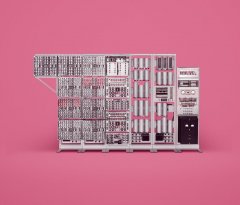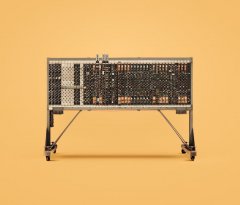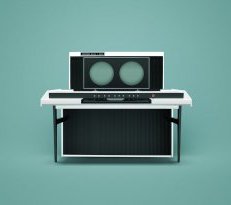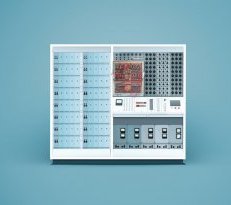Computer Computer Computers
 The first computers had vast space and consumed many energy, with very limited functionality. But the technological revolution has made the computing machines compelling, compact and light, providing them with additional devices and equipment. Contemporary computers are very contrasting with past years ' heroes.
The first computers had vast space and consumed many energy, with very limited functionality. But the technological revolution has made the computing machines compelling, compact and light, providing them with additional devices and equipment. Contemporary computers are very contrasting with past years ' heroes.
The English photographer James Boll (James Ball), also known as Docubyte, has always had a special interest in the first computers:
I like to look at pictures of old computing machines that let us enjoy the benefits of computerization we have.In tribute to his fascination, the photographer decided to create a red series of photos of old computers with historical information about each of them. In his view, black and white photographs could not fully convey all the greatness of these machines.
Harwell Dekatron
 Boll ran research and found the location of the computers he was interested in. Most of them have been in museums for a long time. The photographer formally requested the management of museums to present, in a new, unusual form, machines that changed technology development.
Boll ran research and found the location of the computers he was interested in. Most of them have been in museums for a long time. The photographer formally requested the management of museums to present, in a new, unusual form, machines that changed technology development.
Harwell Dekatron
The British computer Harwell Dekatron was created in 1951. He weighed over 2.7 small (short) tons for 907 kilograms, worked on the relay and was considered a complete computer with a stored program. The energy-dependent memory was built on decatrons, and the data went on perfolt or teletype. Internal memory consisted of 20 8-dimensional decimal registries, but in time it increased to 40. Its low computing power was a significant shortage of the computer.Harwell Dekatron was in service until 1957.
 At the end of 2009, the TNMOC volunteer team used its ingenuity and reinvigorating skills to restore this record computer. In 2012, Harwell Dekatron was re-established at the National Bletchli Park Computing Museum, as part of the project of the Society for Computers. The computer was stored in the Guines Records Book as the " oldest functional electronic computer with a stored software " .
At the end of 2009, the TNMOC volunteer team used its ingenuity and reinvigorating skills to restore this record computer. In 2012, Harwell Dekatron was re-established at the National Bletchli Park Computing Museum, as part of the project of the Society for Computers. The computer was stored in the Guines Records Book as the " oldest functional electronic computer with a stored software " .
Pilot ACE
Pilot ACE is one of the first British computers developed by Alan Turing at the British National Physical Laboratory, NPL, in the early 1950s. It was also one of the first computing machines with a stored program, like other British projects like Manchester Mark I and EDSAC.
Pilot ACE contained almost 800 vacuum lights and computed the floating bay needed for many scientific research. The original memory was 128 words for 32 bats each, but later it was expanded to 352 words. In 1954, a magnetic drum was added in 4096 words. The computer worked on a project tactics frequency of 1 MHz and was the fastest British computer of that time. The speed of implementation of the instructions depended heavily on their location. The decomposition operation ranged from 64 to 1024 microseconds.




Related posts:
 12:14 On 1 September, the new Zoom function extends not only to photos but also to images. 0600 on 1 September, the company is still testing the dice. According…
12:14 On 1 September, the new Zoom function extends not only to photos but also to images. 0600 on 1 September, the company is still testing the dice. According… In gaining the processor, it is necessary to know what objectives the system will focus on. It is worth mentioning that high tactical-frequency multi-nuclear processors…
In gaining the processor, it is necessary to know what objectives the system will focus on. It is worth mentioning that high tactical-frequency multi-nuclear processors… Over the centuries, space has imagined people s imagination. Their thoughts and eyes were turned to heaven, into space. They wanted to go there and even conquer…
Over the centuries, space has imagined people s imagination. Their thoughts and eyes were turned to heaven, into space. They wanted to go there and even conquer… There s only a small part here. Please don t make a mistake. - Contemporary wardrobe, b/o, state of the rules - Blank Wardrobe - Bed Cubus - Large Storage Tomb…
There s only a small part here. Please don t make a mistake. - Contemporary wardrobe, b/o, state of the rules - Blank Wardrobe - Bed Cubus - Large Storage Tomb… A manicure machine, a new ski cure and a virus to control cancer ом in the Machinery program. 5. High technology s manicure machine. The American company presented…
A manicure machine, a new ski cure and a virus to control cancer ом in the Machinery program. 5. High technology s manicure machine. The American company presented… HP has expanded the model numerical computer equipment by launching three new devices in the Pavilion series. All devices are operated by Windows 10. One of the…
HP has expanded the model numerical computer equipment by launching three new devices in the Pavilion series. All devices are operated by Windows 10. One of the… Type of publication: Pirateca Jeanr: business, search for objects, quests, puzzles, for children, balls, arcade, three in row, online developer: Youda Games, Playcamedy…
Type of publication: Pirateca Jeanr: business, search for objects, quests, puzzles, for children, balls, arcade, three in row, online developer: Youda Games, Playcamedy…